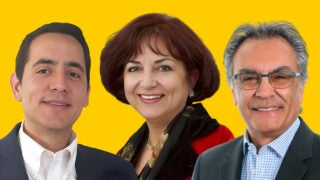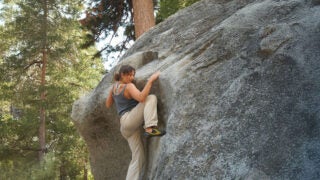Shooting Rockets into Space? There’s a School for That
In Los Angeles, the aerospace industry gets a boost from USC graduates with hands-on experience.
Tim Barrett is crouched over a desk in his garage with a countdown in his head.
“It’s coming in two minutes,” he warns, furiously typing into one of three laptops precariously balanced on the wheeled desk in the alley behind his Playa del Rey home. A few feet away, a 10-foot parabolic tracking antenna pointed skyward starts to swivel. The antenna is following a miniaturized satellite called Aeneas—a USC student project built with both purchased of-the-shelf and custom-made circuits—that’s about to pass overhead in low earth orbit, beaming down its digital vital signs.
“Every day is a new day,” Barrett says with a laugh. “And one of these days it’s going to stop talking to us.” After all, three months is generally considered the lifespan of a CubeSat, a satellite about the volume of a quart-sized carton of milk. As Barrett waits for it, Aeneas (named after the Trojan warrior who personifies duty and courage, naturally) already has flown for more than nine months.
With a blip on the screen, accompanied by a modem screech, the satellite comes through. “It’s talking to us, telling us, ‘I’m alive. My batteries are OK,’ ” says Barrett, associate director of USC’s Space Engineering Research Center (SERC). In lines of code, the satellite sends back its rudimentary heartbeat and vitals in a series of six messages.
Only a few universities nationwide could host this kind of student-driven space project. USC is the only university in the U.S. that offers bachelor’s, master’s and doctoral degrees in astronautical engineering, and SERC drives innovation by giving young engineers the tools to put their fresh ideas into practice.
Part of SERC’s strength comes from its location in Los Angeles, historically a hub of aerospace and astronautics. The local space industry has changed dramatically since the Cold War, as large companies with military ties have gotten leaner and adventurous private firms such as SpaceX, in El Segundo, Calif., have moved in. But one requirement of the industry remains constant: its need for skilled and highly trained engineers who dream of shooting their ever-more-powerful handiworks into space.
Before economic belt-tightening hit the field, it cost $6 million just to build a satellite and $20 million to launch it. That’s changed. As the space industry moves toward building smaller, cheaper and smarter projects that draw on the creative thinking of engineering minds, USC is uniquely poised to jettison graduates into a brave new space world.
A ‘Teaching Hospital’ for Space Research
In 2006, SERC grew out of a need for hands-on training for the aerospace industry, says Joseph Kunc, the center’s director. “The reason industry likes it so much is that when the students enter the labor force, they have been trained to work on all subsystems in a rotating manner. You work on the power, on the engine system, then on the communication system and so forth.”
Students who work with SERC get a unique experience by building and testing equipment and systems that will actually fly in space. They learn from industry engineers who come to USC from local firms. Kunc points out that the center is nimble enough to move as industry changes direction, so students are prepared for different projects. “We keep very intense and close ties with industry to create training that’s exactly what they want,” says Kunc, professor of astronautics, aerospace engineering, physics and astronomy.
The students say that their experiences working with professors and guest teachers from different space groups—from SpaceX to the Jet Propulsion Laboratory—make learning fresh.
“It’s not stale academics to them,” says Michael Ortega ’13. “It’s the things they are working on that week at work.”
Ortega’s experiences working on an innovative lunar lander at SERC facilities at USC’s Information Sciences Institute in Marina del Rey, Calif., make him want to seek out a job as engineering lead in fight operations or systems operations. “I want to work a full life cycle of a project and take a lead role, and that’s something I wouldn’t have known about before SERC,” he says. “Testing things before fight—that’s where you break things. That’s cool.”
Pieter Kranenburg ’13 says working on Aeneas has been uniquely rewarding. “Sending a craft into space and not having it be a tumbling piece of junk is one of the most difficult feats to accomplish,” he says. Since LA is both the birthplace and current hub to cutting-edge aerospace development, “this gives USC students a leg up because of what we can learn just from being surrounded by this community.”
The idea is similar to that of a teaching hospital, says SERC engineering technician Jeffrey Sachs, who worked for 26 years at Hughes Aircraft before joining the center. “I love building spacecraft. Someone trained me, and now it’s my turn to teach others.”
Over the life of one engineering project, Sachs explains, several classes of students will work on the project. The older students are expected to teach the younger ones as they would in a teaching hospital.
Alums also point to the breadth of knowledge they gained at SERC. Working on Aeneas required flexibility and the ability to complete all parts of a project, says Maria Marcela Guzman ’10, MS ’11, who’s now a systems engineer at Raytheon. Guzman says that it’s often difficult for new hires to understand how designing a project and building it fit together—something she implicitly knew from her time at SERC. “You have to understand what’s going on in all the different departments,” she says.
Sometimes limitations can be helpful, Guzman says. “One key factor is that SERC has low-funded projects, which makes you really creative. I learned how to build fixtures that are cheap but that actually work. That opens your mind and helps you to think outside the box.”
Satellites Next to Sailboats
At SERC’s space in the heart of Marina del Rey, students are hard at work in the clean room at the lab despite the lure of summer outside. Only steps away, sailboats cruise through still waters.
Sachs carefully unwraps the first-of-its-kind, half-meter antenna that makes Aeneas so remarkable. The custom-built mesh antenna can gracefully unfold in space, using a Wi-Fi transceiver to get signals from the ground. “It’s the largest parabolic antenna to deploy from a CubeSat,” he explains.
Satellites used to be really oddball shapes. But launch operators now want small satellites that are uniformly shaped, like cubes, so they can put them in standard launch containers and get them into space easily and more economically. The trick is to stow unique equipment in the small container and release it on orbit.
The 10-pound Aeneas satellite is unusual in other ways, too. It’s got technology that may help track cargo around the world in the future.
Right now, cargo-tracking technology loses its signal when cargo containers are a mile from shore—leaving questions about what happens in the open ocean. Technology in Aeneas, though, allows it to track moving cargo from space. Unlike typical satellites that are generally pointed toward a star or another fixed location, Aeneas can stabilize in three different directions, allowing it to rotate and accurately track cargo containers as they move. These sorts of satellites could boost the Department of Homeland Security’s efforts to monitor the movement of goods worldwide.
The group also planned a secondary payload for Aeneas: a new generation of space-borne computer, the Maestro 49-core processor chip, sponsored by the Defense Advanced Research Projects Agency and designed by Boeing. One potential use of such computing power, says Barrett: “You could take images of the ground with a camera and use those images to recognize where you’re trying to fly.” In a way, it’s going back to the way pilots got their bearings, using visual information to point the way and provide a better fight path. It’s likely that the project will fly in 2015.
Soon, students will be able to track their satellites through a dish atop a building at USC, rather than one outside Barrett’s house. Though Aeneas brought many late nights sitting in his garage with the laptops, Barrett remembers fondly the excitement of the satellite’s first beeps home. “The signals are like a string of pearls going across the sky,” he says. “Finding the satellite the first time is a crazy-huge deal.”
Like the satellites, students from SERC take of from USC with years of care and training poured into them. They get the best of all worlds—theoretical training combined with experience building electronics, tracking satellites and testing objects that reach space. “Training with hands-on exposure is rare,” says Sachs.
“We get the students dirty.”
Visit the Campaign for the University of Southern California online to learn how to support SERC and related projects.



